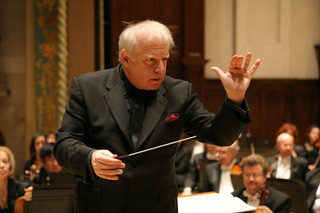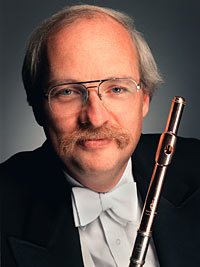|
Back
Lunar Tunes and Edgy Elegies New York
Avery Fisher Hall, Lincoln Center
10/30/2014 - & October 31, November 2, 2014
Aaron Copland: El Salón México
Maurice Ravel: Gaspard de la nuit (Orchestrated by Marius Constant) – Boléro
Christopher Rouse: Flute Concerto (New York Premiere)
Robert Langevin (Flute)
New York Philharmonic Orchestra, Leonard Slatkin Conductor)

L. Slatkin (© Detroit Symphony Orchestra)
The always welcome Leonard Slatkin created a pre-Halloween serious costume party last night, with seven characters who levitated from a wild imagination. He and the New York Philharmonic gave us portraits of a caballero in an all-night Mexican dance hall; a gruesome murdered Irish child; a water-sprite; a man sentenced to death on the gallows; an evil elf; and finally, back to a dance hall in Spain, the dancers probably going insane after repeating the same rhythmic steps 169 times!
But this was music in which Mr. Slatkin excels. He is into the color, the velocity and fire more than introspective. Physically he is always a joy, with crisp signals when necessary, swaying with the rhythms of Aaron Copland’s El Salón México or using infinitesimal finger gestures for Boléro. Two other pieces were premieres in New York, and he cared for the Phil as if it was his own.
The opening Copland, though, was relatively inert. Perhaps the Bernstein performances of El Salón México are almost generic, for we expect a hard-driving, electrifying Mexican salon. Mr. Slatkin never even attempted that, literally pulling in the stops. Copland specified changes of meter, but in picturing the spirit of (what he modestly called) “the tourist’s Mexico”, he still expected an electrifying texture. Mr. Slatkin paused, continued, accelerated, slowed down. In the middle, the somnolent Mexico afternoon was implied, but even the wind solos (sometimes wavering) rarely gave us the fire in the Mexican belly. (And no jokes please about Montezuma’s revenge.)
The final dance of the evening, Boléro was taken at a fast pace, though Ravel of course wanted a slow even music, lulling us into the two-part rhythm. Mr. Slatkin thought otherwise. (And in a few jaded listeners, the conductor should get it over with as quickly as possible.)
Of the two premieres, Christopher Rouse’s Flute Concerto was the most sheerly beautiful work I had heard from our Composer-In-Residence. Too often this one-time Rock percussionist goes back to his roots, longing for orchestral “shouting” while the music’s message comes closer to whispering.
In the 1990’s, though, Mr. Rouse went through a different phase with two concertos, for trombone and flute. It was more introspective, it was (in his words), “Looking for the light”, although much of the music was inspired by the death of people.
He never knew James Bolger, but the two-year-old Irish child who was beaten to death, was the subject, an unerringly beautiful subject, of five movements, each with a different mood. The first and last, with the Celtic name for “song” (Amhrán) , was simple, lyrical mirrors of each other. The second was a march, and the fourth, very much an Irish Wake–in other words, a jig and variations, all merry enough but rather dark.
It was the elegy which had that 18th Century American chorale songfulness in which Mr. Rouse excels. Yes, it sounds much like a Henry Cowell “fuging” tune, but Mr. Rouse, with his string orchestra firmly in tow, made these homages to the child almost unbearably moving. Yet amidst the lament, the slight dissonances of flute and orchestra gave it a jagged undertow. One was moved in two ways. Emotionally, yes, but also moved to admire that the emotions were kept taut, never saccharine, never maudlin. The facts and notes spoke for themselves.

R. Langevin (© Chris Lee/New York Philharmonic)
And so did Robert Langevin. Since James Galway left his post of Principal Flute of the Berlin Philharmonic many years ago, no orchestra has had a flute-player with the shine, the glitter, the polish and the strength of Mr. Langevin. His performance of the Rouse still vibrates in my mind.
I had never heard the work before (this was a New York premiere), but I hope that he records it, for I cannot imagine a more powerful performance.
The second great novelty was Ravel’s Gaspard de la nuit, this time not for piano, but for full orchestra, orchestrated by the man who gave us the ultimate Halloween theme, from Twilight Zone. In a very enlightening introduction, Maestro Slatkin gave us piano samples and their orchestral equivalents, along with Mr. Constant’s role as the very first Professor of Orchestration at the Paris Conservatory.
That seemed most unlikely, until one realized that the brilliant orchestration of Berlioz, Bizet, Debussy, Ravel, Massenet and Fauré came just because they had to paint the music themselves, and didn’t have professors of templates from which to copy.
Yet one must ask how well Marius Constant did in this most pianistic of all Ravel compositions. It was partly a great success. Yes, Mr. Constant inevitably reflected Ravel’s La Valse and especially the Rapsodie espagnole. But he did an excellent job in the depicting water sprite, giving a chilling gallows and the darkness of the evil elf, Scarbo.
Mr. Slatkin wisely suggested that those who didn’t know the piano work would probably enjoy the orchestration on its own. Those of us who either play or revel in Ravel’s totally Halloween-ish macabre vision on the piano, those who hear those chords without any full orchestra with harps and drums and bass clarinets and malevolent ensembles behind it, saw Mr. Constant’s orchestration as a terrifically adept audacity.
Harry Rolnick
|